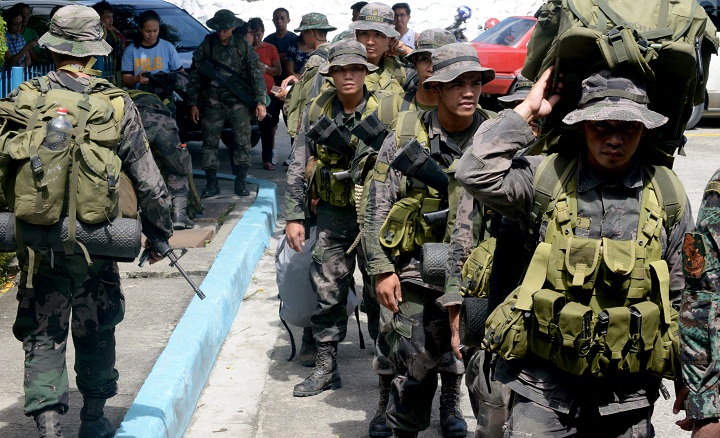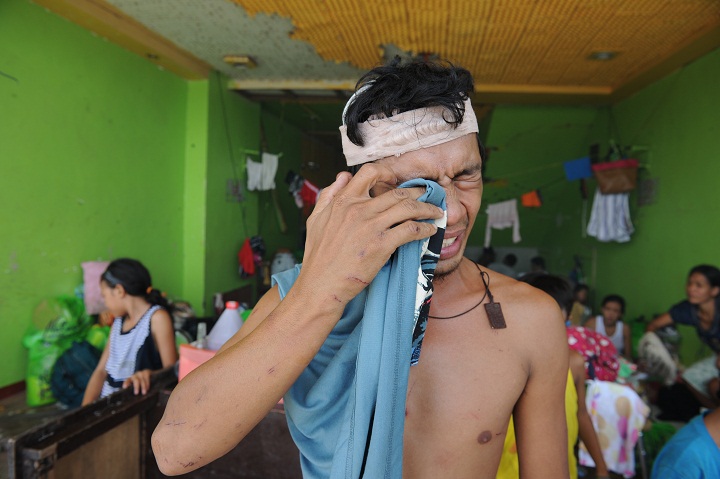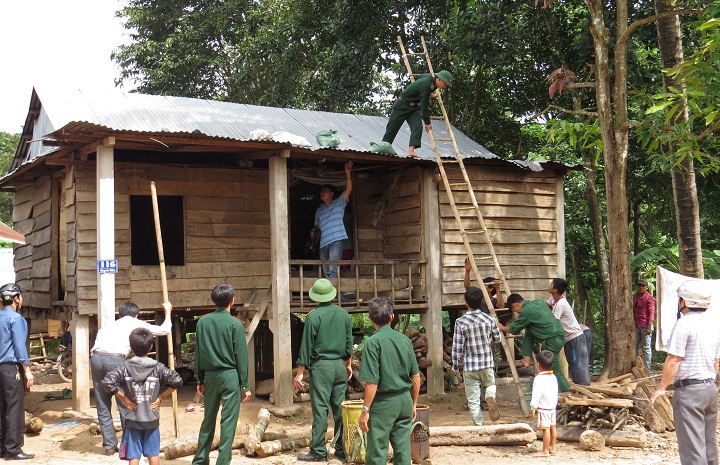Video: The UN says 2.5 million survivors desperately need food and water after Typhoon Haiyan tore through the Philippines. Global National’s Paul Johnson reports.

- Canadians needing urgent consular help following Typhoon Haiyan can email sos@international.gc.ca or call collect 613-996-8885.
- Canadian Red Cross is accepting donations here
- Shaw Communications has opened Filipino channels TFC and FTV for viewing without subscription, and all long-distance calls to the Philippines will be offered to all customers at no additional cost until further notice.
TACLOBAN, Philippines – Typhoon-ravaged Philippine islands faced a daunting relief effort that had barely begun Monday, as bloated bodies lay uncollected and uncounted in the streets and survivors pleaded for food, water and medicine.
Police guarded stores to prevent people from hauling off food, water and such non-essentials as TVs and treadmills, but there was often no one to carry away the dead – not even those seen along the main road from the airport to Tacloban, the worst-hit city along the country’s remote eastern seaboard.
Canada has announced that it will match dollar-for-dollar donations from Canadians. That is on top of a $5-million contribution the government said it would give to support humanitarian organizations helping the victims.
The Ontario government announced Monday afternoon that it would contribute $1 million to the Red Cross to assist in relief efforts, and provide “other supports as requested” in the future.
Disaster relief organization Canadian Medical Assistance Teams (CMAT) will be deploying its disaster assessment team to the Philippines “in the coming days,” according to a release.
READ MORE: Typhoon Haiyan leaves up to 10,000 dead in Philippines
At a small naval base, eight bloated corpses – including that of a baby – were submerged in sea water brought in by the storm. Officers there had yet to move them, saying they had no body bags or electricity to preserve them.
Two officials said Sunday that Friday’s typhoon may have killed 10,000 or more people, but with the slow pace of recovery, the official death toll remained well below that. The Philippine military confirmed 942 dead, but shattered communications, transportation links and local governments suggest the final toll is days away. Presidential spokesman Edwin Lacierda said “we pray” that the death toll is less than 10,000.
TV5 Manila reporter Erel Cabatbat told Global News it’s difficult to gauge an official death toll because the only way to communicate with other provinces and cities is for someone to walk “several hours for several kilometres” on foot.
“With the enormous area being affected by the typhoon, it’s really quite impossible right now to gather all the necessary information to ascertain the real extent of the damage and how many people really died or how many are still missing,” said Cabatbat.
Tacloban resembled a garbage dump from the air, punctuated only by a few concrete buildings that remained standing.
“I don’t believe there is a single structure that is not destroyed or severely damaged in some way – every single building, every single house,” U.S. Marine Brig. Gen. Paul Kennedy said after taking a helicopter flight over the city. He spoke on the tarmac at the airport, where two Marine C-130 cargo planes were parked, engines running, unloading supplies.
Cabatbat said most people were only able to save the clothes on their back amid the destruction.
“People have lost their homes, their livelihood…People are searching for food,” he said, noting he’d heard stories of drug stores and other businesses being looted for supplies and potable water.
Authorities said at least 9.7 million people in 41 provinces were affected by the typhoon, which is called Yolanda in the Philippines but is known as Haiyan elsewhere in Asia. It’s one of the most powerful recorded typhoons to ever hit land and likely the deadliest natural disaster to beset this poor Southeast Asian nation.
READ MORE: Canada expresses sympathy to Typhoon Haiyan victims

Get breaking National news
Philippine soldiers were distributing food and water in Tacloban, and assessment teams from the United Nations and other international agencies were seen for the first time. The U.S. military dispatched food, water, generators and a contingent of Marines to the city, the first outside help in what will swell into a major international relief mission.
“Please tell my family I’m alive,” said Erika Mae Karakot, a survivor on Tacloban’s Leyte island, as she lined up for aid. “We need water and medicine because a lot of the people we are with are wounded. Some are suffering from diarrhea and dehydration due to shortage of food and water.”
Authorities said they had evacuated some 800,000 people ahead of the typhoon, but some of the evacuation centres proved to be no protection against the wind and rising water. The Philippine National Red Cross, responsible for warning the region and giving advice, said people were not prepared for a storm surge.
“Imagine America, which was prepared and very rich, still had a lot of challenges at the time of Hurricane Katrina, but what we had was three times more than what they received,” said Gwendolyn Pang, the group’s executive director.
Emily Ortega, 21 and about to give birth, was among those who had thought she was safe. But the evacuation centre she had fled to was devastated by the 6-meter (20-foot) storm surge, and she had to swim and cling to a post to survive. She reached safety at the airport, where she gave birth to a baby girl. Bea Joy Sagales appeared in good health, and her arrival drew applause from others in the airport and military medics who assisted in the delivery.
The winds, rains and coastal storm surges transformed neighbourhoods into twisted piles of debris, blocking roads and trapping decomposing bodies underneath. Ships were tossed inland, cars and trucks swept out to sea and bridges and ports washed away.
“In some cases the devastation has been total,” said Secretary to the Cabinet Rene Almendras.
Residents have stripped malls, shops and homes of food, water and consumer goods. Officials said some of the looting smacked of desperation but in other cases items taken included TVs, refrigerators, Christmas trees and a treadmill. An Associated Press reporter in the town said he saw around 400 special forces and soldiers patrolling downtown to guard against further chaos.
Brig. Gen. Kennedy said Philippine forces were handling security well, and that his forces were “looking at how to open up roads and land planes and helicopters. We got shelter coming in. (The U.S. Agency for International Development) is bringing in water and supplies.”
Those caught in the storm were worried that aid would not arrive soon enough.
“We’re afraid that it’s going to get dangerous in town because relief goods are trickling in very slow,” said Bobbie Womack, an American missionary and longtime Tacloban resident from Athens, Tennessee. “I know it’s a massive, massive undertaking to try to feed a town of over 150,000 people. They need to bring in shiploads of food.”
Womack’s husband, Larry, said he chose to stay at their beachside home, only to find the storm surge engulfing it. He survived by climbing onto a beam in the roof that stayed attached to a wall.
“The roof was lifting up and the wind was coming through and there were actual waves going over my head,” he said. “The sound was loud. It was just incredible.”
READ MORE: Why Super Typhoon Haiyan was so destructive
Marvin Daga, a 19-year-old student in Tacloban, tried to ride out the storm in his home with his ailing father, Mario, but the storm surge carried the building away.
They clung to each other while the house floated for a while, but it eventually crumbled and they fell into churning waters. Marvin grabbed a coconut tree with one hand and his father with the other, but Mario slipped out of his grasp and sank.
“I hope that he survived,” Marvin said in an army medic room as tears filled his eyes. “But I’m not expecting to find him anymore.”
Philippine President Benigno Aquino III said in a statement he had a declared a “state of national calamity” allowing the central government to release emergency funds quicker and impose price controls on staple goods. He said the two worst-hit provinces, Leyte and Samar, had witnessed “massive destruction and loss of life” but that elsewhere casualties were low.
Video: Dramatic rescue as typhoon Haiyan hits Philippines
The storm’s sustained winds weakened to 120 kph (74 mph) as the typhoon made landfall in northern Vietnam early Monday after crossing the South China Sea, according to the Hong Kong meteorological observatory. Authorities there evacuated hundreds of thousands of people, but there were no reports of significant damage or injuries.
It was downgraded to a tropical storm as it entered southern China later Monday, and weather officials forecast torrential rain in the area until Tuesday. No major damage was reported in China, though Xinhua News Agency said heavy winds tore a cargo ship from its moorings in southern China and drove it out to sea, killing at least two crew members.
The Philippines, an archipelago nation of more than 7,000 islands, is annually buffeted by tropical storms and typhoons, which are called hurricanes and cyclones elsewhere. The impoverished and densely populated nation of 96 million people is in the northwestern Pacific, right in the path of the world’s No. 1 typhoon generator, according to meteorologists. The archipelago’s exposed eastern seaboard often bears the brunt.
Even by the standards of the Philippines, however, Haiyan was an especially large catastrophe. Its winds were among the strongest ever recorded, and it appears to have killed more people than the previous deadliest Philippine storm, Thelma, in which about 5,100 people died in the central Philippines in 1991.
The country’s deadliest disaster on record was the 1976 magnitude-7.9 earthquake that triggered a tsunami in the Moro Gulf in the southern Philippines, killing 5,791 people.
Associated Press writers Oliver Teves and Teresa Cerojano in Manila and Minh Tran in Hanoi, Vietnam, contributed to this report.
With files from Global News


























































































Comments